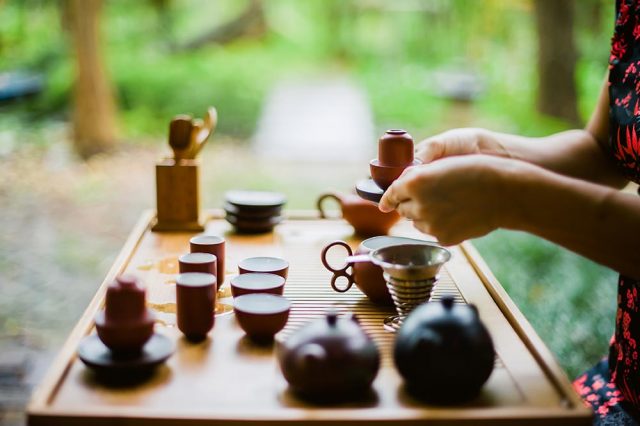Chinese tea ceremony: Tradition and meditation
In the modern world, we have an almost intimidating variety of tea. From the most traditional, such as Matcha (green tea), Earl Gray or Darjeeling, to exotic blends, through herbal, fruity, floral teas; spiritual mixtures, with spices, with caffeine, with ingredients obtained in any corner of the world; those that are said to be ideal for curing colds, indigestion, and even emotional ailments. Today, I will talk about the Chinese tea ceremony.
It should be clarified that, traditionally, tea is actually that drink that results from pouring hot water on leaves of the tea plant ( Camellia sinensis). These leaves can be cured and treated in various ways, resulting in the base for white tea, green tea, black tea, pu-erh, oolong, etc. All of these are varieties of tea in the strict sense of the word. Herbal, fruity, floral teas, etc., are actually infusions.
Trying to talk about the specific properties of each type of tea is a very ambitious task, which is not really the focus of today’s article. However, we would love to embark on that adventure later. Let us know in the comments if you want more information about the properties of the various varieties of tea!
What our note today is really about is the virtues of tea in general; of its properties as a millenary drink and, more specifically, of its traditional use as a ritual element and a tool for meditation and mindfulness.
The Chinese tea ceremony

The Chinese tea ceremony is basically a ritualized way of preparing, serving, and presenting tea. It is an ancient cultural activity, practiced by various Asian cultures.
The ways of consuming this drink, in terms of occasions, way of preparation, and customs, differ from our ways in the Western world, and there are even cultural differences between Asian countries that have developed formal ceremonies around tea.
China, widely recognized as the birthplace of tea, has a thousand-year-old tradition around the drink. There are numerous gestures, rituals, and implements related to its preparation and consumption. Although it is a drink for regular consumption, served at every gathering, from the most casual visit to the most formal of events, there are some special circumstances in which tea plays an essential role. For example, when celebrating a wedding, as part of a formal apology, as a sign of respect and as a way to strengthen a relationship.
The Chinese tea ceremony is best known in the Western world. During the 19th century, tea was introduced to Japan from China, and with it, its ritual ceremony began to unfold. This, in turn, is strongly influenced by the Chinese traditions of the “art of tea”.
The Chinese ritual is extremely complex, full of subtleties, gestures, words and phrases that are expected of each of its participants. In addition, the procedure may vary according to the tradition of each school, the season, the place where it takes place, the time of day, and various other considerations. Every action – how to use the kettle, examine the cup, pour the tea powder – is done in a deliberate and specific way. It is a ritual inseparable from Zen and meditation practices.
There are other ritual customs around Tea. In Korea, there are rules of etiquette and ceremonies that have been preserved for over a thousand years. India, currently the second-largest tea producer after China, has a long tradition of herbal teas as a result of the practice of Ayurveda. Vietnam and Taiwan also have their own customs.
In addition, tea houses are an important cultural component in some countries of the Middle East and Africa, particularly in Morocco, the main importer of green tea worldwide.
The traditions related to the preparation and consumption of tea are, in general, of a meditative, reflective nature. The Tea Ceremonies invite us to transform a mundane moment into a special occasion, through a pause destined to beautify the simple act of enjoying a hot drink.
They also have a social component, which makes them vehicles to strengthen relationships, strengthen bonds of trust, loyalty and friendship, or simply connect with the other in a peaceful environment.
Tea as a meditation tool
For several years, those who are in search of well-being and fuller life, have known how to look to the ancient Asian traditions as a source of wisdom. Practices and disciplines such as Yoga, Trataka, Ayurveda, and other types of alternative medicine have been inserted into our daily lives.
So it is not surprising that more and more people find in the rituals of the Tea Ceremonies a source of inspiration to practice their own rituals of contemplation.
It should be noted that traditional Tea Ceremonies are cultural elements of great importance, inseparable from the culture that originated them. To perform the Chinese ceremony, for example, requires years of study, preparation and practice, even a lifetime.
However, we can find in them a guide, an invitation to stop in time and focus all our attention on the simple act of making and enjoying a cup.
Mindfulness in your cup of tea
The hectic pace of our daily lives can make finding time to meditate an impossible task. However, we can take advantage of small daily actions to find in them a moment in which to focus and appreciate the present.
Preparing and enjoying a good cup of tea in a contemplative attitude can be an excellent Mindfulness practice . You can create your own routine to do when you wake up and start the morning with a fresh attitude, or in the afternoons to reflect on the day that is leaving. Here are some steps and ideas for meditating with your cup of tea.
Get good raw material
It is recommended that you buy a good quality tea. It is always better if it is not the one that comes in bags, since you make sure that it is fresher. It is also preferable that it is tea and not an infusion, but if you cannot part with your herbal or floral mixtures, make sure they are made with noble ingredients.
It is also a good idea to have a specially reserved teapot and cup for your little Chinese tea ceremony.
Prepare the space
Whenever possible, clean and prepare the place where you will prepare and drink your tea before using it. A clutter-free space helps to reflect that state of clarity within you.
You can spend time choosing the decoration and arranging the arrangement of your furniture. For this purpose, it is better not to use aromatherapy elements, as they interfere with the enjoyment of the aroma of your tea.
Boiling the water
When we bring the water to a boil, most of us leave it on the fire and retire to do something else while we wait (read, get dressed, check the cell phone, etc). However, remember that we are now focusing 100% of our attention on the preparation of tea.
Be present while the water boils. Listen carefully and connect with your breath. If you have a glass teapot, you can enjoy watching the bubbles grow. Much of you is made of water; find that connection.
Prepare the tea and let it steep
Once the water is ready, it is time to pour it over the tea leaves or matcha powder. Watch the steam rise and breathe deeply, enjoying its aroma and warmth.
Now you need to let the tea settle. Put your hands around the mug, letting its warmth wash over you. Take the moment to empty your mind and focus exclusively on that feeling. You can also pour your gratitude towards the people who made this cup of tea possible; those who have invested time and effort sowing, caring for the plant and collecting its leaves. You can choose a topic on which to meditate, exploring it thoroughly, concentrating with all your attention.
Enjoy
Once the tea has settled, it is time to enjoy it. Drink it thoroughly, slowly, taking small sips. Focus all your attention on the drink; become a tea taster. What flavors do you find in it? How is its consistency? Is it light or intense? How does its temperature change as you drink?
Focusing on those feelings will allow you to be more alert and pay more attention to the small details of everyday life. More present life is a fuller life. Go ahead and try it!













Post Comment